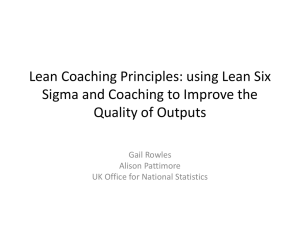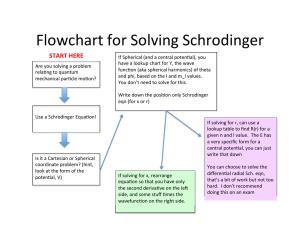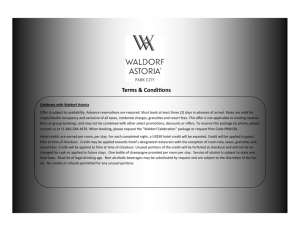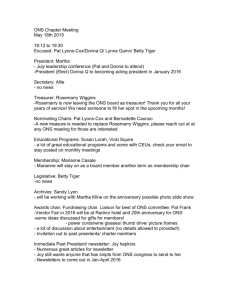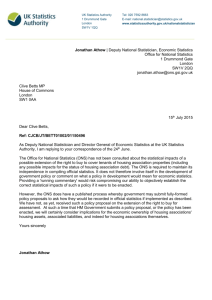Document 10791921
advertisement
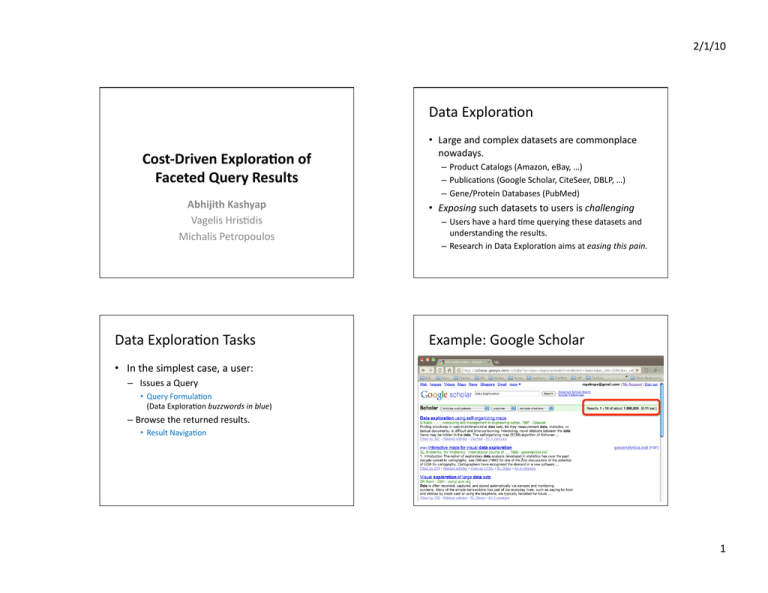
2/1/10 Data Explora/on Cost-­‐Driven Explora2on of Faceted Query Results Abhijith Kashyap Vagelis Hris/dis Michalis Petropoulos Data Explora/on Tasks • Large and complex datasets are commonplace nowadays. – Product Catalogs (Amazon, eBay, …) – Publica/ons (Google Scholar, CiteSeer, DBLP, …) – Gene/Protein Databases (PubMed) • Exposing such datasets to users is challenging – Users have a hard /me querying these datasets and understanding the results. – Research in Data Explora/on aims at easing this pain. Example: Google Scholar • In the simplest case, a user: – Issues a Query • Query Formula/on (Data Explora/on buzzwords in blue) – Browse the returned results. • Result Naviga/on 1 2/1/10 Data Explora/on Challenges Approaches to Simplify Data Explora/on • Users have difficulty in formula/ng queries • Query Formula/on – Simple Keyword based interface (a la Google) – Unfamiliarity with underlying data or its structure. – Many queries are underspecified • Limited expressivity. – Advanced Search form • Informa/on Overload: Most queries issued against such datasets return a large number of results. – Users have trouble naviga/ng large resultsets looking for results that sa/sfy their informa/on need • Difficult to Build and difficult to use. – Query Autocomplete • Works for a small number of keywords. Some recent representa/ve works: • • • • Advanced Search Google Scholar DISCOVER: Keyword Search in Rela2onal Databases. Vagelis Hris/dis, Yannis Papakonstan/nou. VLDB 2002 Automated Crea2on of a Forms-­‐based Database Query Interface Magesh Jayapandian and H. V. Jagadish VLDB Auckland, New Zealand VLDB 2008 Combining Keyword Search and Forms for Ad Hoc Querying of Databases. Eric Chu, Akanksha Baid, Xiaoyong Chai, AnHai Doan and Jeffrey Naughton. SIGMOD 2009. Type Less, Find More: Fast Autocomple2on Search With a Succinct Index. H Bast, I Weber. SIGIR 06. Approaches to Simplify Data Explora/on (cont’d) • Results Naviga/on – Results Ranking – Results Categoriza/on 2 2/1/10 Results Ranking Results Categoriza/on • Results Ranking • Organizes the results into categories – Present an ordered list of results, ordered by a predefined Ranking func/on • PageRank (Brin et. al.) • ObjectRank (Hris/dis et. al) • Many others (see works by V. Hris/dis, S. Chaudhuri) – Problems: • Difficult to explain and customize – Ranking is not aligned with user preference • Problem becomes harder with structured data Example: Unstructured Data Google news – A category can be either: • A flat list of terms • Organized in an ontology or a concept hierarchy – Typically more than one – Used in conjunc/on with ranking • Each categoriza/on of the results is oien referred to as a facet – Focus of this work (and presenta/on) Example: Structured Data Amazon.com Hierarchical Facet Flat Facet 3 2/1/10 Results Categoriza/on (cont’d) Example: Amazon.com (cont’d) • Categoriza/on reduces the user effort during Results Naviga/on. • Users navigate the results by selec/ng condi/ons from one or more facets. • Each selec/on narrows down the results. (or refines the query) • The user refines the results un/l she narrows down to the subset of results that sa/sfies her informa/on need. Example: Amazon.com (cont’d) The results have narrowed down significantly Two more condi2ons selected Faceted Naviga/on • The user navigates the facet classifica/on instead of the results. • This classifica/on is typically smaller and beker organized than the resultset • Problems: – The facet classifica/on is not small enough • The set of all available choices can easily overwhelm the user. • Amazon was a very simple example – Try naviga/ng DBLP or Genome databases. 4 2/1/10 Hidden Slide Managing Faceted Naviga/on • You might need a more tedious example than Amazon here • How should the facets and facet condi/ons be presented to the user? • Solu/on: Show only a small subset of facets and facet condi/ons – Almost all interfaces select facets and condi/ons based on cardinality (number of results). – Can result in sub-­‐op?mal naviga/on! – Remember: The objec/ve is to decrease user effort. Example: Amazon.com (cont’d) “Top” categories aren’t necessarily the best Managing Faceted Naviga/on: Our Approach • Idea: – The objec/ve is to decrease user effort. – So, select the set of facet condi/ons that minimize the user effort and show them to the user. • Problems: – How to measure user effort? – Even if we could, how do me measure it even before the user begins the naviga/on? 5 2/1/10 Measuring User Effort • A user naviga/ng the results spends /me and effort in: Example: Example: Amazon.com (cont’d) The total cost of naviga/on in the previous example of “asus laptop” is: 21 (facet condi2ons) + 4 (refinements) + 18 (results) = 43 – Reading the labels of facet condi/ons – Deciding and clicking on the selec/ng the facet condi/on – Reading the resultset. • Each of the above ac/on contributes to naviga/on effort or naviga/on cost Decreasing Naviga/on Effort • In the above naviga/on, the user went through: Electronics >> Computers… >> Laptops >> Windows Vista • Instead, if the naviga/on had – landed directly in laptops, the cost would be: 6 (opera2ng systems) + 1 (refine) + 18 (results) = 25! – Could have been even less if fewer choices for opera/ng systems were shown. – Gets beker with more facets and more complex datasets. Cost-­‐Based Approach Decreasing Naviga/on Effort • We claim: A decreased naviga/on cost translates to: – Fewer naviga/on ac/ons • User reach the results they are interested in quickly – Decreased naviga/on /me – Beker user experience • And, experiments support the claim. 6 2/1/10 Example Result Sets and Facets Cost-­‐Based Naviga/on • Problem Statement: FACET-­‐SELECTION • Given – RQ: result of a query Q – C(RQ ): the facet classifica/on of RQ – Select a subset CS(RQ) of C(RQ ), such that the overall naviga/on cost is minimized. – Constraint: C(RQ ) should cover RQ i.e. the set of condi/ons should not hide away any result. Example Compu/ng Naviga/on Cost • Remember: Naviga/on cost is the func/on of user ac/ons naviga/ng the result set RQ. – i.e., cost depends on sequence of user interac/on with the interface. • Therefore, to compute naviga/on cost, we need a model of user naviga/on that: – Follows the ac/ons of user in the interface. – Captures the naviga/on cost 7 2/1/10 Naviga/on Ac/ons • SHOWRESULT (RQ) :-­‐ The user reads through all the results in RQ • REFINE(Q, c) :-­‐ The user chooses a suggested condi/on c ϵ CS(RQ) and refines query Q , that is, Q becomes Q ∧ c. • EXPAND (Ai, RQ) :-­‐ The user is dissa/sfied with (rejects) all suggested condi/ons in CS(RQ). – Instead, he selects an akribute Ai and selects one of the non-­‐suggested condi/on c’ϵCS(RQ)\C(Ai) Naviga/on Model Formally: Cost Model • Given RQ , CS(RQ) and the set of user ac/ons performed by the user, the total naviga/on cost can be (approximately) computed. 8 2/1/10 Cost Model Example Cost Model (cont’d) RQ • But, we have to suggest facet condi/ons before the naviga/on begins! Make Year State Color t1 Honda 2001 NY Red t2 Honda 2005 NY Green t3 Honda 2001 NY Gold t4 Honda 2005 NY Green t5 Toyota 2005 NY White t6 Toyota 2005 NY CS(RQ) Color • Red (1) • White (1) • Green (2) • Gold (1) • Black (1) Black • If the user clicks on Green and then sees the two results, the total cost is: |Cs (RQ)|=5 + 1 (REFINE(Q,color=Green)) + 2 (SHOWRESULTS) = 5 + 1 +2 = 8 – These condi/ons should poten&ally minimize the naviga/on cost. • We (have to) do the next best thing: – Es/mate it! Cost Model Naviga/on Cost Es/ma/on Cost Model Modeling Uncertainty • At each step, the user has several choices: • SHOWRESULT Probability PSR(RQ): This is the probability that the user examines all tuples in the result set and thus terminates the naviga/on. • REFINE Probability P(c): This is the probability that the user refines the query Q by a suggested condi/on c ϵ CS(RQ). • EXPAND Probability PE(RQ): The probability that the user does not choose a suggested condi/on and instead performs an EXPAND ac/on – REFINE, EXPAND or SHOWRESULTS. • Since the ac/ons of the user are not known in advance… • …we associate uncertainty measures with each of these ac/ons. – These uncertainty measures also capture user preference 9 2/1/10 Cost Model Compu/ng Es/mated Cost Cost Model Cost Formula Explana/ons The total expected cost of naviga/on is given by: • If the user selects SHOWRESULT, the expected naviga?on cost is PSR(RQ)|RQ|. • Else, the user chooses to con/nue faceted naviga/on with expected cost – (1-­‐PSR(RQ)) ⨉ (amortized cost of Facet Navigation) Cost Model Cost Formula Explained Compu/ng Suggested Condi/ons Algorithms • Naïve Algorithm • The user first examines all suggested condi/ons CS(RQ) with cost |CS(RQ)| • Then the user either: – Refines with est. cost: (1-­‐PE(RQ)) ⨉ refine(Q, CS(RQ)) – Expand with est. cost: PE(RQ) ⨉ (amortized cost of Expand) – At each naviga/on step, for each set of candidate facet condi/ons – Compute the cost formula in Equa/on 1 seen previously – Return the set of condi/ons that have the minimum naviga/on cost • Problem: Exponen/al! O(22n). 10 2/1/10 Complexity Results Compu/ng Suggested Condi/ons Heuris/cs • FACET-­‐SELECTION problem is NP-­‐Hard • We prove hardness for a simpler version of the problem: • To efficiently select the best set of suggested condi/ons, we propose 2 heuris/cs. – NAVIGATE-­‐SINGLE: Given RQ and C(RQ ), where all akributes of RQ are boolean (0,1). WLOG assume that all condi/ons in CS(RQ ) are posi/ve. – The problem is to then select the set of condi/ons that cover the result RQ and is smallest in size. 1. ApproximateSetCover Heuris/c 2. UniformSugges2ons Heuris/c – Theorem: NAVIGATE-­‐SINGLE is NP-­‐COMPLETE – Reduc/on from HITTING-­‐SET Problem Computing Suggested Conditions Compu/ng Suggested Condi/ons ApproximateSetCover Heuristic ApproximateSetCover Heuris/c • Given a resultset RQ and its facet classifica/on C(RQ), The objec/ve is to compute the set of suggested condi/ons CS(RQ), such that: • Weighted set cover problem – given a set system (U, S), such that , and weights w:S-­‐>R+, find a subfamily F such that and is minimal. • There is a linear /me approxima/on algorithm for the weighted set cover problem – CS(RQ) covers RQ – Expected naviga/on cost is minimal. • This problem closely resembles the well-­‐ known NP-­‐hard weighted set cover problem! – V. Chvatal: A Greedy Heuris2c for the Set Cover Problem. Mathema/cs of Opera/ons Research 4(3): 233-­‐235 (1979) 11 2/1/10 Compu/ng Suggested Condi/ons ApproximateSetCover Heuris/c Compu/ng Suggested Condi/ons ApproximateSetCover Heuris/c • To the approxima/on algorithm, we need to define the weight func/on: • Because, based on the cost formula, – The condi/on chosen should have a high P(c). – Otherwise, the probability of the user choosing EXPAND , increases significantly. Compu/ng Suggested Condi/ons Example • In the first itera/on, the algorithm selects Make=Honda, since this facet condi/on covers 4 results and has the maximum value of P(c)|RQ∧c| amongst all the condi/ons in C(RQ) • In the next itera/on, two results (t1 & t3) remain uncovered and are covered by facet condi/on Year=2005 Compu/ng Suggested Condi/ons UniformSugges/ons Heuris/c • In this heuris/c, we follow the cost formula more closely. • Evalua/ng sugges/ons using the cost formula is very expensive. – Because it involves recursively evalua/ng the cost equa/on for each combina/on of candidate facet condi/ons (O(22n) in total). 12 2/1/10 Compu/ng Suggested Condi/ons Compu/ng Suggested Condi/ons • Idea, • Based on a (long winded) analysis of the cost model [see sec/ons 3.3 & 6.2], • We came up with a simplified version of the cost formula :-­‐ UniformSugges/ons Heuris/c – The combinatorial recursion of the cost formula creates a recursion tree that is both wide and deep! – Instead of evalua/ng this large tree, which considers a set of sugges/ons, • Evaluate a bunch of small trees, one for each candidate. • i.e. evaluate each condi/on independently. Compu/ng Suggested Condi/ons UniformSugges/ons Heuris/c UniformSugges/ons Heuris/c -­‐ That can evaluate each condi/on independently. UniformSugges/ons Heuris/c Example 13 2/1/10 Filling in the Gaps Filling in the Gaps • Es/ma/ng prob. of SHOWRESULT: PSR(RQ) • Intui/on, • Es/ma/ng PA(Ai) and P(c): Es/ma/ng Probabili/es – If the results are widely distributed, then the user would probably REFINE the results – Else, the user would be beker off reading the results Es/ma/ng Probabili/es – These probabili/es are subjec/ve measures of user preference – Can be es/mated in mul/ple ways • Data Frequency, Explicit User Preference, Mining Query Logs, etc. • Therefore, we use the informa/on theore/c measure of entropy to measure PSR(RQ): • In this work, we es/mate: Experiments Datasets • We perform experiments to: • Yahoo! UsedCars – Validate the cost model • To see if it actually reduces naviga/on cost. – Compare it with exis/ng state-­‐of-­‐the art[1] – See what users think about it: User Study [1] S. B. Roy, H. Wang, G. Das, U. Nambiar, M. K. Mohania: Minimum-­‐Effort Driven Dynamic Faceted Search in Structured Databases. CIKM 2008 – PA(Ai) by query logs – P(c): by data frequency – 15,191 cars – 41 Facets – 7 categorical, 3 numeric and rest Boolean • IMDB Movies database – ~40K movies – All Facets categorical – Some facets are set valued; each movie has mul/ple actors etc. 14 2/1/10 Experiment Methodology Results: UsedCars • For each dataset, – we select a number of queries – 10 each – for each query, we designate a random result as the target of naviga/on • We count the number of naviga/on ac/ons (cost) required to reach the target result – In a guided random simula?on Results: UsedCars Results: IMDB dataset 15 2/1/10 Results: IMDB dataset User Study We measure the following: 1. The actual ?me it took users to navigate to designated target tuples using different interfaces 2. How realis/c is our cost model, by studying the rela/onship of the actual /me (actual cost) 3. The users percep?on of the faceted interfaces through a ques/onnaire 1. FACeTOR, 2. Amazon-­‐Style, which suggests at most 5 facet condi/ons with the highest cardinality for each akribute, and 3. One-­‐akribute-­‐at-­‐a-­‐/me INDG, where an akribute is selected at each step and all its condi/ons are displayed User Study: Results 180 160 140 Actula Time (sec) User Study: Comparisons 120 100 80 60 40 20 0 AVG FACeTOR 1 2 3 Amazon-­‐Style 4 5 6 7 8 INDG 16 2/1/10 User Study: Results User Study: Survey Es2mated Cost (Equa2on 1) 350 300 250 200 150 100 50 0 0 20 40 60 80 100 120 140 160 180 Actual Time (sec) FACeTOR Amazon-­‐Style INDG Linear(FACeTOR) Linear(Amazon-­‐Style) Linear(INDG) We asked the following ques/ons: 1. Quality Of Sugges2ons: Did the sugges/ons presented at each naviga/on step make the task of finding the target car(s) easier? 2. Quan2ty of Sugges2ons: Were the number of sugges/ons presented at each step sa/sfactory? 3. Difficulty in Selec2on: At each naviga/on step, how difficult or easy was to decide which facet condi/on to choose? User Study: Survey 20 15 10 17 14 7 19 17 30 18 15 2 2 1 2 4 Difficult 7 2 Too Few Just Right Too Many (c) Quantity of Suggestions 22 25 10 11 0 (a) Quality of Suggestions 15 9 5 5 Very Difficult 20 11 10 0 Very Easy Easy 17 20 8 5 24 25 25 17 10 9 17 12 11 3 5 5 0 Very Easy Easy Difficult 5 0 0 Very Difficult (b) Difficulty in Selection FACeTOR Amazon-­‐Style INDG 17


